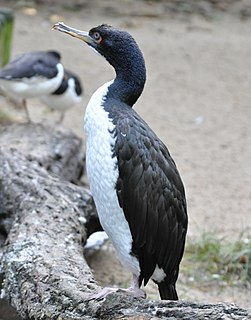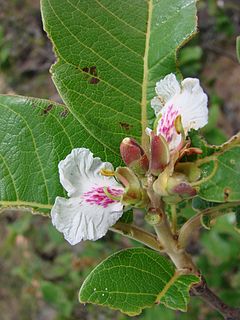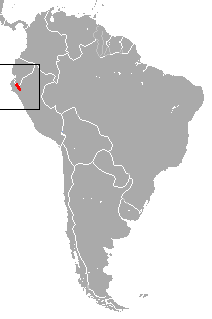
Burmeister's porpoise is a species of porpoise endemic to the coast of South America. It was first described by Hermann Burmeister, for whom the species is named, in 1865. Locally it is known as marsopa espinosa and chancho marino.

The Guanay cormorant or Guanay shag is a member of the cormorant family found on the Pacific coast of Peru and northern Chile. After breeding it spreads south to southern parts of Chile and north to Ecuador, and has also been recorded as far north as Panama and Colombia – probably a result of mass dispersal due to food shortage in El Niño years. Its major habitats include shallow seawater and rocky shores.

The Para dog-faced bat, also called the brown dog-faced bat, is a South American bat species of the family Molossidae. It is found in Panama, Colombia, Ecuador, Peru, Venezuela, Guyana, Surinam, French Guiana, Brazil, and northern Argentina.

Euryoryzomys nitidus, also known as the elegant oryzomys or elegant rice rat, is a rodent species in the family Cricetidae. Previously it was known as Oryzomys nitidus, but it is not closely related to Oryzomys as that genus is now constructed. Its range includes Bolivia, Brazil and Peru to the east of the Andes, in lowland tropical rainforest as well as forest in the eastern foothills of the mountains, at elevations from 50 to 2,000 m.

Itaya amicorum is a medium-size fan palm that is native to Brazil, Colombia and Peru. It is the only species in the genus Itaya. It was unknown to science until 1972, when it was discovered on the bank of the Itaya River in the Peruvian Amazon.
Wettinia longipetala is a species of tree in the family Arecaceae. It is found only in Peru, and is considered a vulnerable species by the IUCN.

The ancient antwren is a species of bird in the family Thamnophilidae. It is found in northern Peru and southeastern Ecuador. Its natural habitat is subtropical or tropical moist lowland forests. It is threatened by habitat loss.

The northern pudu is a species of South American deer native to the Andes of Colombia, Venezuela, Peru and Ecuador. It is the world's smallest deer. and is classified as Data Deficient in the IUCN Red List.
Euplassa isernii is a species of plant in the family Proteaceae. It is endemic to Peru.
Ipomoea pulcherrima is a species of plant in the family Convolvulaceae. It is endemic to Peru.
Qualea calantha is a species of plant in the Vochysiaceae family. It is endemic to Peru.

Qualea is a flowering plant genus in the family Vochysiaceae. These plants occur in the Neotropics and their wood makes good timber and firewood and is used in construction. Some species of Qualea have medicinal properties.
Roupala pinnata is a species of plant in the family Proteaceae. It is endemic to Peru.
Roupala sphenophyllum is a species of plant in the family Proteaceae. It is endemic to Peru.
Pleradenophora membranifolia is a species of plant in the family Euphorbiaceae. It ranges from Peru to central Brazil.

The Peruvian small-eared shrew is a species of mammal in the family Soricidae. It is known only from northern Peru, where it has been found in shrubby "elfin" cloud forest in the Andes at elevations from 2050 to 3150 m. The species may also be present in Ecuador. It has the southernmost range of any shrew in South America.
Anoura peruana is a species of bat from Colombia and Peru. It was elevated to a species in 2010, after previously being considered a subspecies of Geoffroy's tailless bat. The females are larger than the males.
Qualea elegans is a species of flowering plants in the family Vochysiaceae. It is found in Brazil.

Qualea parviflora, known as pau-terra in Portuguese, is a deciduous tree indigenous to Bolivia, Brazil, and Paraguay. The tree favors dry climates like the tropical savanna of the cerrado.
Qualea tessmannii is a species of tree that is part of the family Vochysiaceae.










